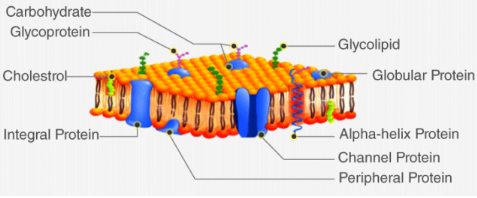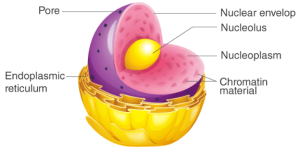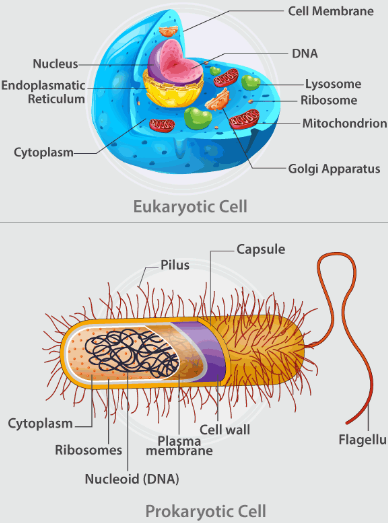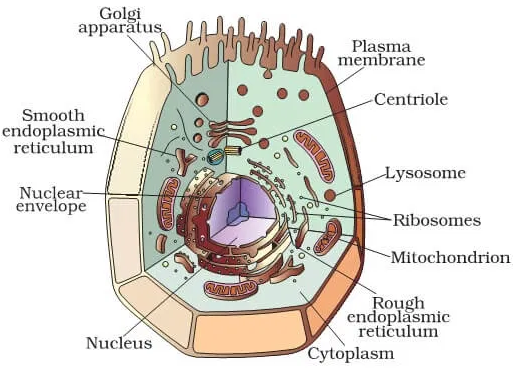Notes For All Chapters Science Class 9 CBSE
1. Discovery of the Cell
Robert Hooke’s Observation (1665)
Robert Hooke examined a thin slice of cork (the bark of a tree) using a self-designed microscope.
He saw it resembled a honeycomb structure, made up of many tiny compartments.
He called these compartments cells (from Latin cellula, meaning “small room”).
This was the first observation that living things consist of small units.
Further Discoveries
| Scientist | Contribution |
|---|---|
| Anton van Leeuwenhoek (1674) | Discovered free-living cells in pond water. |
| Robert Brown (1831) | Discovered the nucleus in cells. |
| Purkinje (1839) | Coined the term “protoplasm” (the living content of a cell). |
| Schleiden (1838) and Schwann (1839) | Proposed the Cell Theory: all plants and animals are composed of cells, and the cell is the basic unit of life. |
| Rudolf Virchow (1855) | Added: “All cells arise from pre-existing cells.” |
| Electron Microscope (1940) | Helped scientists observe the detailed structure of cells and their organelles. |
2. What Are Living Organisms Made Up Of?
Unicellular and Multicellular Organisms
Unicellular organisms: Consist of a single cell that performs all life functions.
- Examples – Amoeba, Paramoecium, Chlamydomonas, Bacteria.
Multicellular organisms: Made up of many cells.
Each group of cells performs specific functions (division of labour).
- Examples – Plants, animals, fungi.
Function of Cells
- Each cell performs certain basic functions like respiration, nutrition, excretion, etc.
- In multicellular organisms, cells are specialized — e.g., nerve cells transmit signals, muscle cells contract.
- In unicellular organisms, a single cell performs all necessary life functions.
Types of Cells (based on shape)
| Cell Type | Function / Structural Feature |
|---|---|
| Nerve Cell | Long and branched to transmit messages. |
| Blood Cell | Round and flexible to move through blood vessels. |
| Muscle Cell | Elongated to help contraction and movement. |
| Sperm Cell | Tail for movement. |
| Fat Cell | Spherical, stores fat. |
| Ovum | Round and large, helps in fertilisation. |
3. Structure of a Cell
Cells show three main parts visible under a microscope:
- Plasma Membrane (Cell Membrane)
- Nucleus
- Cytoplasm
3.1 Plasma Membrane or Cell Membrane
Structure
- Outermost covering of the cell (in plants, just inside the cell wall).
- Made of lipids and proteins.
- Flexible and selectively permeable – allows some substances to pass through but not others.
Functions
- Separates the internal cell content from the external environment.
- Controls the entry and exit of materials.
- Allows gases like oxygen and carbon dioxide to move by diffusion.
- Regulates water movement by osmosis.
Diffusion
Movement of molecules from higher concentration to lower concentration.
Examples:
- CO₂ formed during cellular respiration diffuses out of the cell.
- O₂ required for respiration diffuses into the cell.
Osmosis
Movement of water molecules through a selectively permeable membrane from a region of higher water concentration to a lower one.
Three Conditions:
| Surrounding Solution | Description | Effect on Cell |
|---|---|---|
| Hypotonic Solution | Outside medium has higher water concentration (more dilute) | Water enters cell → cell swells |
| Isotonic Solution | Equal water concentration inside and outside | No net movement → cell remains same size |
| Hypertonic Solution | Outside medium has lower water concentration (more concentrated) | Water leaves cell → cell shrinks |
Activities
- Egg in pure water: swells (osmosis, water enters).
- Egg in salt solution: shrinks (water leaves by osmosis).
- Raisins in water: swell.
- Raisins in sugar solution: shrink.
Endocytosis
The cell membrane can engulf solid food or liquid materials from outside.
Example: Amoeba engulfs food through endocytosis.
3.2 Cell Wall (in Plants)
- Rigid outer layer outside the plasma membrane.
- Made of cellulose.
- Provides strength, shape, and protection.
Function
- Prevents bursting when cell absorbs water.
- Allows plants to survive in hypotonic environments.
- Plasmolysis: Shrinkage of cell contents away from the cell wall when water leaves the cell through osmosis.
Only living cells show plasmolysis; dead cells do not.
3.3 Nucleus
Structure
- Spherical or oval dark body near the centre.
- Surrounded by double-layered nuclear membrane with pores.
- Contains:
- Nucleoplasm
- Chromatin Material (thread-like, becomes chromosomes during division)
- Nucleolus
Functions
- Controls all cell activities (the “control centre”).
- Contains DNA – carries genetic information.
- Functional units of DNA are genes.
- Helps in cell division and inheritance.
3.4 Cytoplasm
- Jelly-like fluid between nucleus and cell membrane.
- Contains all cell organelles suspended in it.
- Allows movement of materials and chemical reactions.
- In prokaryotes, cytoplasm lacks membrane-bound organelles.
- In eukaryotes, cytoplasm contains well-developed organelles.
Difference Between Prokaryotic and Eukaryotic Cells
| Feature | Prokaryotic Cell | Eukaryotic Cell |
|---|---|---|
| 1. Nucleus | Not well defined. Nucleus is absent; DNA lies freely in cytoplasm in a region called nucleoid. | Well defined nucleus present, enclosed by a nuclear membrane. |
| 2. Nuclear Membrane | Absent. | Present. |
| 3. Chromosomes | Single circular chromosome. | More than one (linear chromosomes). |
| 4. Cell Size | Smaller in size (about 1-10 µm). | Larger in size (about 5-100 µm). |
| 5. Cell Organelles | Membrane-bound organelles absent. (No ER, Golgi body, mitochondria, etc.) | Membrane-bound organelles present. (ER, Golgi apparatus, mitochondria, lysosomes, plastids, etc.) |
| 6. Example | Bacteria, Blue-green algae (Cyanobacteria). | Plant cells, Animal cells, Fungi, Protists. |
| 7. Ribosomes | Small ribosomes (70S). | Larger ribosomes (80S). |
| 8. Cell Division | By binary fission (simple division). | By mitosis or meiosis. |
| 9. Cell Wall Composition | Made up of peptidoglycan (murein). | In plants, made of cellulose; in animals, absent. |
| 10. Complexity | Simple and primitive structure. | Complex and advanced structure. |
Difference between Animal cell and Plant cell
| Feature | Plant Cell | Animal Cell |
|---|---|---|
| 1. Cell Wall | Has a cell wall made of cellulose outside the plasma membrane, providing rigidity and protection. | No cell wall – only plasma membrane present. |
| 2. Shape | Usually fixed, rectangular, or box-like shape due to cell wall. | Usually round or irregular in shape. |
| 3. Vacuole | Has a large central vacuole (can occupy 50-90% of the cell’s volume) filled with cell sap. | Has small or temporary vacuoles, or may be absent. |
| 4. Plastids | Present (e.g., chloroplasts, chromoplasts, leucoplasts). Chloroplasts contain chlorophyll and perform photosynthesis. | Absent – plastids are not found in animal cells. |
| 5. Mode of Nutrition | Autotrophic – can make its own food using chloroplasts (photosynthesis). | Heterotrophic – depends on other organisms for food. |
| 6. Nucleus Position | Nucleus is pushed to the periphery by the large vacuole. | Nucleus is centrally located. |
| 7. Centrioles | Absent (except in lower plant forms). | Present – helps in cell division. |
| 8. Lysosomes | Rare or absent, as waste materials are usually stored in vacuoles. | Present – known as the “suicide bags” of the cell. |
| 9. Mitochondria | Present – site of energy release (ATP). | Present – site of energy release (ATP). (Common in both) |
| 10. Golgi Apparatus and ER | Present (usually larger and scattered). | Present (smaller and compact). (Common in both) |
Animal cell:
Plant Cell
3.5 Cell Organelles and Their Functions
(i) Endoplasmic Reticulum (ER)
- Network of membrane-bound tubes and sheets.
- Two types:
- Rough ER (RER): with ribosomes – makes proteins.
- Smooth ER (SER): no ribosomes – makes fats (lipids), detoxifies drugs and poisons.
- Functions:
- Transports materials within cell.
- Membrane biogenesis (helps make new membranes).
- Provides a surface for biochemical reactions.
(ii) Golgi Apparatus
- Stack of flattened sacs called cisterns.
- Connected to ER.
- Functions:
- Modifies, stores, and packages materials from ER.
- Forms lysosomes.
- Involved in making complex sugars from simple ones.
(iii) Lysosomes
- Small, membrane-bound sacs with digestive enzymes.
- Formed by Golgi apparatus and RER.
- Functions:
- Digest worn-out organelles, bacteria, and waste materials.
- Destroy the entire cell if it is damaged → hence called “Suicide Bags”.
(iv) Mitochondria
- Known as “Powerhouse of the Cell”.
- Double membrane: outer porous, inner folded (cristae).
- Releases energy in form of ATP (Adenosine Triphosphate) during respiration.
- ATP – energy currency of the cell.
- Have their own DNA and ribosomes, so they can make some proteins themselves.
(v) Plastids (Present only in plant cells)Two main types:
- Chromoplasts: coloured plastids (contain pigments).
- Leucoplasts: colourless, store food (starch, oils, proteins).
Chloroplasts: green plastids with chlorophyll, perform photosynthesis.
Like mitochondria, plastids also have their own DNA and ribosomes.
(vi) VacuolesMembrane-bound sacs for storage.
Plant Cells: one large central vacuole (up to 90% of cell volume).
Animal Cells: small and temporary vacuoles.
Functions:
- Store water, sugars, amino acids, organic acids.
- Maintain turgidity and rigidity in plants.
- In Amoeba, food vacuole stores ingested food.
- In some unicellular organisms, helps expel excess water.
4. Cell Division
Purpose:
Growth, repair, and reproduction in living organisms.Types:
- Mitosis
- Meiosis
| Type | Description | Function |
|---|---|---|
| Mitosis | One parent cell divides into two identical daughter cells. | Growth and repair of tissues. |
| Meiosis | One parent cell divides twice → four daughter cells with half chromosomes. | Formation of gametes for reproduction. |
Mitosis Fig:-
Meiosis Fig:-









We have great full to you but add diagram 👌👍
Great job.
ya it is very helpfull but i am not able to download the pdf so please post pdf of this
More diagrams related to this chapter please…..